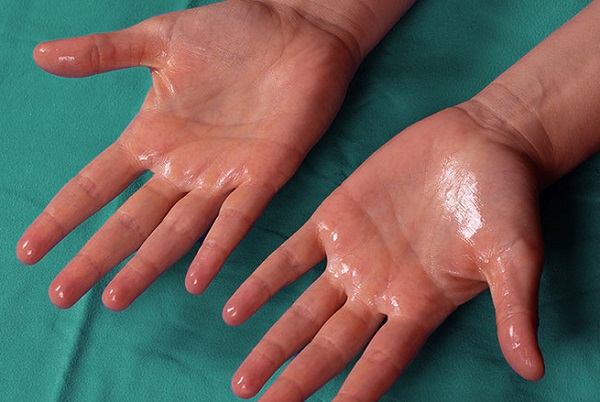At some point in your life, you have encountered someone whose hands are always sweaty, regardless of the weather. As a student, you may have even witnessed their struggle with torn books and malfunctioning pens due to the excess sweat from their hands while writing, sparking curiosity about their condition. This common phenomenon is known as sweaty palms, but medically, it is referred to as palmar hyperhidrosis.
Despite its prevalence, palmer hyperhidrosis often goes on undiscussed, leaving people affected by it with no clue of what exactly it is about.
According to a study, between 1-3% of the general population experience palmar hyperhidrosis, affecting both sexes equally. It is typically presented during childhood or adolescence.
Without further ado, here is what you need to know about palmar hyperhidrosis.
What is palmar hyperhidrosis?
Palmar hyperhidrosis is a medical condition in which a person sweats excessively and unpredictably from their hands.
This condition happens when one sweats more than what the body needs to regulate temperature.
Normally, sweating happens naturally and helps the body stay cool. People sweat more in warm temperatures, when they exercise, or in response to situations that make them nervous, angry, embarrassed, or afraid.
However, people with palmar hyperhidrosis may experience sweating when at rest, in cold temperatures, or randomly at times when sweating is not expected.
What causes palmar hyperhidrosis?
Palmar hyperhidrosis is caused by overactive sweat glands.
The eccrine glands which are the sweat glands create sweat to cool down the body when it gets hot. However, if one has palmar hyperhidrosis, that means the eccrine glands activate and produce sweat more often than when the body is too hot.
However, there are other causes which include:
- Genetic factor: A study has found that genetics may play a role in the development of palmar hyperhidrosis. That means people who have a family history of palmar hyperhidrosis are at risk of having the condition.
- Emotional causes: Stress, anxiety, and fear can cause palmar hyperhidrosis. These strong emotions can lead to the spontaneous release of sweat. The sweating may continue until the emotion is eased.
- Hormonal changes: Hormonal fluctuations, such as those occurring during puberty, pregnancy, or menopause, may influence sweat production and contribute to this condition.
- Medical conditions: Certain underlying health issues may be associated with palmar hyperhidrosis according to research. Medical conditions include obesity, stroke, and diabetes.
- Overdose of certain drugs and alcohol intake can also cause palmar conditions. Drugs like insulin can disrupt hormone levels or cause nerve hypersensitivity.
What are the symptoms of palmar hyperhidrosis?
Some common symptoms of palmar hyperhidrosis include:
- Excessively sweating of hands
- Hands that are cold to the touch
- Pale or blush coloring of the hands
- Sweating in the hands from everyday tasks such as writing or holding
- Abrupt onset of sweating episodes
- Fear of situations that require hand contact
- Swelling of the fingers
How is palmar hyperhidrosis treated?
There are a wide variety of treatment options available for patients with this condition — ranging from topical to surgical, depending on its severity.
These treatments include:
- Antiperspirants: Antiperspirants can be applied to the palms to reduce sweat production.
- Anticholinergics: These medications block the chemical signals that stimulate sweat glands, reducing sweat production.
- Botox: Botulinum toxin injections can temporarily block nerve signals to the sweat glands by releasing acetylcholine, a neurotransmitter, to reduce the amount of sweat the glands in the palms produce.
- Iontophoresis: Iontophoresis involves the use of a device that delivers a low electrical current to the palms to block the sweat gland activity.
- Endoscopic thoracic sympathectomy (ETS): In severe cases, surgical procedures such as ETS may be considered as a last resort. ETS is a minimally invasive procedure that is done to permanently disrupt the nerves that stimulate sweat production.
Palmar hyperhidrosis has been proven to have a significant negative impact on patients’ lives. So it is important to seek medical attention for proper diagnosis and treatment to improve quality of life.
Copyright 2025 TheCable. All rights reserved. This material, and other digital content on this website, may not be reproduced, published, broadcast, rewritten or redistributed in whole or in part without prior express written permission from TheCable.
Follow us on twitter @Thecablestyle

